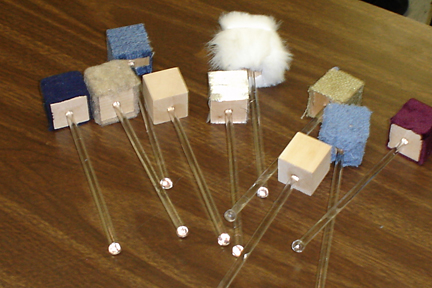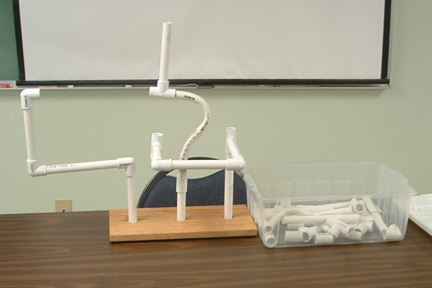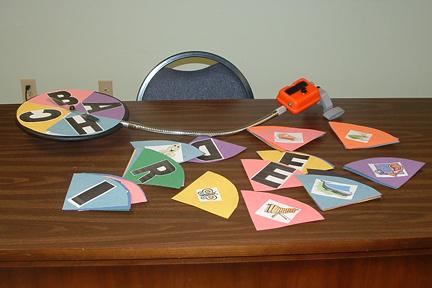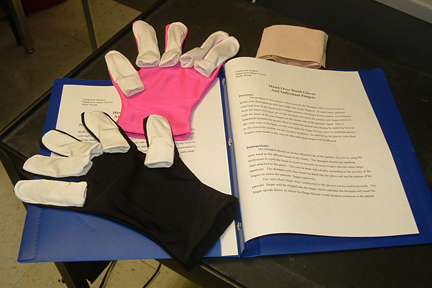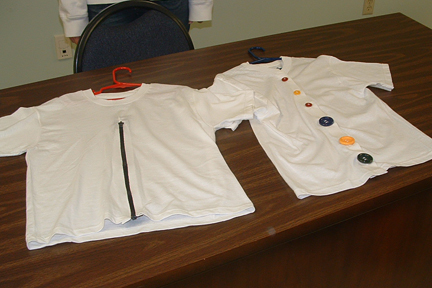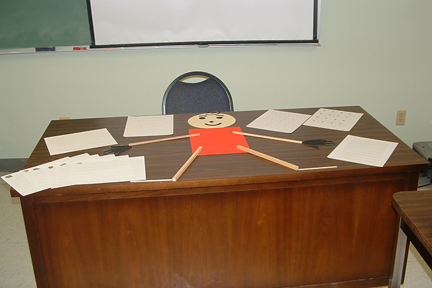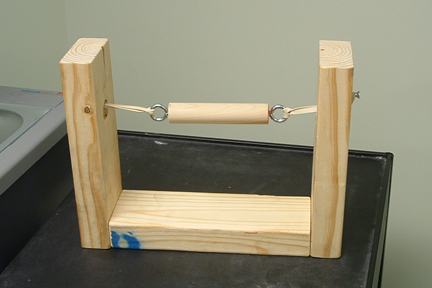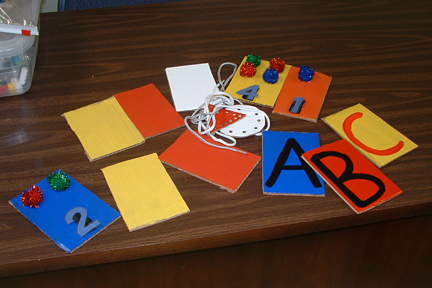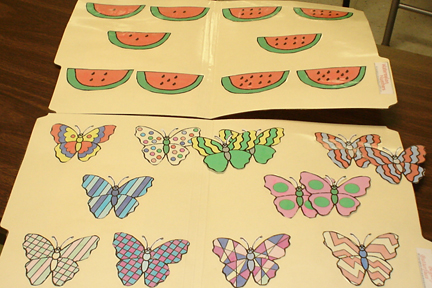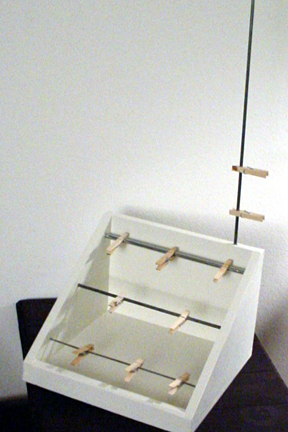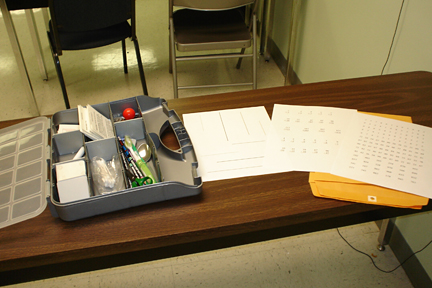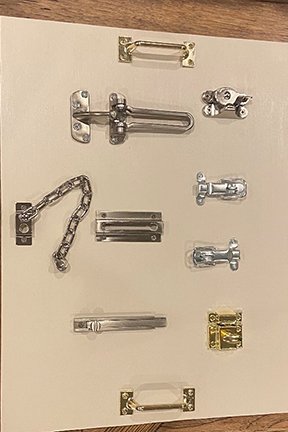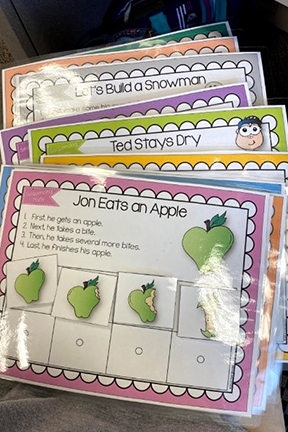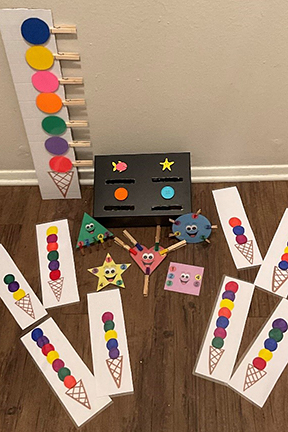Department of Occupational Therapy
Extensor Glove

Purpose: The purpose of the extensor glove is to promote strengthening of the digits.
Preparation: Resistance on each finger should be provided by the occupational therapist to prevent
injury. Resistance may be increased or decreased by adding/taking away a rubber band.
Once the proper resistance is applied to each finger the patient can begin various
exercises including: PIP extension, MCP extension, and thumb abduction.
Dressing Cube

Purpose: To improve and increase bilateral skills, fine motor skill, eye hand coordination
and strength.
Dressing Cube Tasks: Side 1: Zippers Side 2: Buckles (As shown) Side 3: Buttons of various sizes Side
4: Bra strap with snaps Side 5: Belt buckle Side 6: Three-pronged buckles
Geoboard

This set of three geoboards is based on the Visual Perceptual Skills Program. It includes
a 5-pin, 9-pin and 25-pin board, rubber bands, 200 designs and a foam mat. These boards
can be used as a fun activity to work on visual perceptual skills. Although, this
activity is mostly used with school aged children, it can be used with older individuals.
The therapist places the board at midline in front of the child, then places a design
to the left of the board and asks him/her to copy the design on the geoboard using
rubber bands. A rubber band should be used for each line of the design. The design
presented should match or slightly challenge the skills of the client. Colored rubber
bands can be used to increase contrast between the different lines of the design.
The child progresses from the 5-pin to the 9-pin and then to the 25-pin. The boards
can be used independently from the designs and vice-versa. The therapist can draw
a design and ask the child to copy it on the geoboard or present the child with one
of the design card and ask him/her to copy it on a sheet of paper.
There are some safety concerns with the boards. Since they are made of nuts and bolts,
caution should be exercised with children. A mat should be placed underneath the board
to prevent the board from moving and damaging the table.
Paper Placement Stabilizer

Purpose: To assist with holding paper in place when performing handwriting tasks.
Desensitization Tools

Purpose: To provide clients with a variety of tactile stimuli to increase sensory tolerances
by providing a range of touch sensations from smooth to rough textures. Ten (10) desensitization
sticks are included with a variety of material used to apply the square tip ends with
different materials on each end. The plastic sticks used to hold the square tip may
be cleaned after each patient with a sanitizer to decrease spread of germs. Textures
include: satin, suede, fur, velour, fleece, denim, terry cloth, burlap, crepe, & plush
felt.
Procedure: Place the texture of choice on the square end of the stick on points of the skin
surface that need to be desensitized. Gently apply soft strokes to the skin surface
or have the client apply the texture to his or her self during the process. Textures
ranging from smooth to rough may be applied and graded from least to most noxious.
Textures that seem to be the main noxious stimulus may be used individually as deemed
appropriate by the therapist. Apply throughout treatment sessions as appropriate to
facilitate increased tolerance to different textures.
Pipe Tree

Purpose: Improve fine and gross motor UE movements. Increase endurance. Improve finger strength
and dexterity. Improve static and dynamic sitting and standing balance. Promote trunk
and hip stability. Promote eye-hand coordination. Promotes bilateral UE movements.
Promote crossing midline.
Instructions: The client should try and replicate a pattern or create his/her own with the various
pieces.
Device To Assist With Letter Recognition

Purpose: To encourage letter recognition. Encourage scanning. Encourage use of assistive technology.
This project was specifically designed for an individual who is visually impaired
and has CP. This device connects to a wheelchair and can be adjusted to a preferred
height and distance. The device is activated by using a switch. Once the switch is
activated the dial will turn. Once the switch is pressed again the dial will stop
on a letter which the client is to identify. This kit contains 26 letters and a picture
designated for each letter. The device will hold 4 letters or pictures at a time.
Hand Over Hand Gloves with Individual Fingers

Purpose: The purpose of this project is to provide the therapist with a way to work on ROM
with those patients that have tone in their finger(s). In most cases, patients' with
tone in the hand and/or fingers present with finger flexion and /or wrist flexion.
The hand over hand glove can assist with patient with finger extension with the input
of the therapist's fingers o the dorsal side of the patient's hand. In addition to
the gloves, individual fingers were made in the case of only individual fingers being
affected.
Mastering Fasteners and Zippers

Purpose: The purpose of this project is to provide children who have difficulties with buttons
and zippers assistance an aid that will allow them to practice these tasks during
therapy or throughout the day. Manipulating fasteners and buttons is an important
task for a child to be able to perform independently. The therapist can either leave
the shirts in the classroom with the child or take them with him/her to each therapy
session.
Interventions for School Based Therapy

Purpose: This activity can be incorporated into many areas of treatment seen in a school based
setting. Activities offered in this project allow the OT to make copies and adapt
worksheets to handwriting skills specific to their plan of treatment. This kit assists
with handwriting legibility, letter sizing, letter formation, closure, spacing and
body schema when using Mat Man. Mat Man is a simulated body building activity.
Wrist and Forearm Exerciser

This device is designed to exercise the muscles of the writ and forearm particularly
the flexor carpi ulnaris, flexor carpi radialis, extensor carpi ulnaris and extensor
carpi radialis longus. The device should be positioned on a stable surface with the
open part facing the ceiling. The client can be seated with the shoulder flexed or
standing with the arm adducted and grasping the small handle. The client performs
radial deviation of the wrist and returns to the starting position controlling the
movement back. The client then performs ulnar deviation of the wrist and returns to
its original position. The can also hold the position at the end of the range for
an amount of time to provide stretch to the muscles, improve strength and endurance.
This device can also, be used to work on forearm pronation and supination. Hooding
the same starting position as mentioned above (forearm pronated), the client supinates
the forearm and then returns to its starting position controlling the movement back.
The starting position can be changed to supination with pronation now being resisted.
The supinated or pronated position can be help for an amount of time to provide stretch,
improve strength and endurance.
The design of the device allows for easy change of the rubber bands or addition of
multiple rubber bands providing different levels of resistance and grading of the
activity.
Color, Number and Alphabet Cards

Color Cards: Have child identify the color of each card. Have child match the cards by color.
Number Cards: Have child match the correct number with the correct card. Have child count out loud
the number of fuzz balls on each card
Alphabet Cards: Have the child identify the letters of the alphabet. Have the child make the shape
of each letter, either on top of the card or to the side, with pipe cleaners. Have
the child place the letters if the alphabet in the correct sequence.
File Folder Games

Purpose: Sequencing, Problem solving skills, Enhance visual scanning, Promote eye-hand coordination,
Learning basic skills (ABC’s, counting 1-10, shapes, matching)
View Preschool Education website for additional resources.
Graded Pinch Exerciser
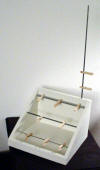
Project Description: The graded pinch exerciser is designed to provide pinch and ROM challenges for upper
extremity rehabilitation patients. The pinch exerciser is a box approximately one
square foot with a slanted front, three horizontal rods, and one vertical rod (see
Figure 1). The horizontal rods are three different diameters, providing a graded challenge
from bottom to top. The vertical rod extends approximately 2½ feet from the base of
the box, requiring approximately 90-150° of shoulder flexion when the patient is seated
an arms-length from the top of the vertical rod. The graded pinch exerciser is designed
to be used with graded resistance pinchpins available from rehabilitation suppliers,
such as Sammons Preston.
Objectives:
- Increased pinch strength.
- Increased finger coordination.
- Increased upper extremity ROM.
Positioning: Sitting or standing with a good base of support and the pinch exerciser easily in
reach and directly in front of the patient. Patient should be comfortable. For ROM
exercises, the patient should be seated an arms-length away from the top of the vertical
rod.
Visual Perceptual Testing Kit

Purpose: This kit was designed to test the following visual perceptual skills:
- Ocular Alignment
- Visual Fixation
- Light Touch
- Saccadic Eye Movement
- Convergence
- Visual Spatial Inattention
- Position and Motion
- Ideomotor and Ideational Apraxia
- Right-Left Discrimination
- Unilateral Body Neglect
- Somatognosis
- Constructional Apraxia
- Orientation
- Finger Agnosia
- Form Discrimination
- Depth Perception
- Figure Ground Perception
- Spatial Relations
- Topographical Disorientation
- Visual Object Agnosia
- Tactile Agnosia
- Problem Solving
- Mental Flexibility
- Stereognosis
Latches and Lock Board

Purpose: The purpose of the Latches and Locks Board is to help the intended population practice
and gain the skills to lock and unlock latches and locks that may be present in their
home. This is to improve safety in case of an emergency, as well as increase life
skills.
Visual Sequencing Mats

Purpose:To enhance sequencing, problem solving, and visual processing abilities. The goal
of this activity is to build on sequencing skills with clients who have cognitive
deficits as a result of a variety of conditions or injuries.
Task Box, Ice Cream Clothespin Activity, Shape/Color Clothespin Activity

Purpose:To enhance sequencing, problem solving, and visual processing abilities. The goal
of this activity is to build on sequencing skills with clients who have cognitive
deficits as a result of a variety of conditions or injuries.







